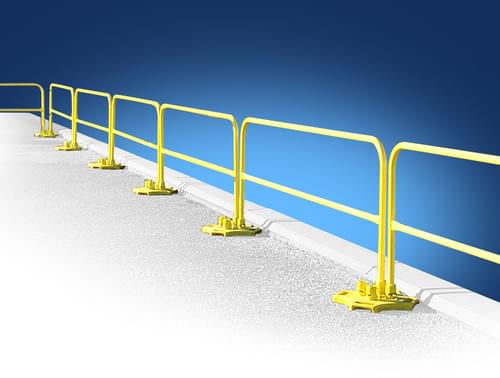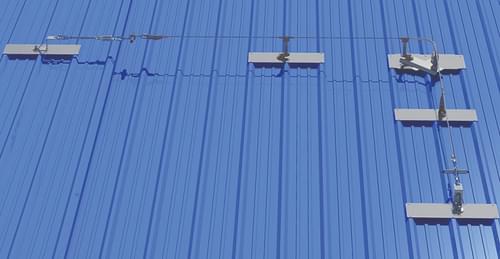Regardless of your industry or the size of your facility, protecting workers from being injured while on the job is of the utmost importance. This is especially true whenever employees are required to perform their duties at height, like on your building's rooftop. That means providing passive fall protection like metal guard rail and safety railing systems. However, active fall protection like safety harnesses and a life line system may also be necessary in some cases. You have a duty to provide fall protection, but every case is unique and so is every facility. It's up to you to figure out which type of device is best suited for your situation and to make sure your employees use them properly.
Industrial rooftops harbor a variety of slip, trip, and fall hazards for employees. The roof's leading edge, roof openings like skylights, access ladders, and the building's HVAC system all pose a potential risk. Protecting workers from these and other workplace hazards is a requirement under the regulations set by the Occupational Safety and Health Administration (OSHA). Non-compliance can result in an increase in workplace injuries, OSHA citations, fines, lost productivity, and other disturbances to your business.
Anytime workers are exposed to elevated surfaces, especially rooftops, the best fall protection practices begin with eliminating risk factors. Whenever possible, keep workers off of the rooftop when wind, rain, snow, or other weather hazards make conditions dangerous. Make sure tools, equipment, and supplies are kept neatly stored and protected. When it's not possible to eliminate the risks, a passive fall protection system is imperative. In other cases, an active fall protection system may also be required.
 As you'd suspect, a passive fall protection system is a static, fixed, or unmoving barrier that protects workers from falls. It's an effective means of keeping people within a safe area. It doesn't require any special training for employees, there's no additional equipment necessary, and it requires no interaction from a person to provide protection. The most common passive fall protection systems include:
As you'd suspect, a passive fall protection system is a static, fixed, or unmoving barrier that protects workers from falls. It's an effective means of keeping people within a safe area. It doesn't require any special training for employees, there's no additional equipment necessary, and it requires no interaction from a person to provide protection. The most common passive fall protection systems include:
 Unlike its passive counterparts, active fall protection requires some action on the part of the worker for it to provide any protection. Employees need to be trained on how to properly inspect, don, and use active fall protection, as well as how to perform a self-rescue, or assist a co-worker who has fallen and is restrained. Some active fall protection devices provide fall arrest protection while others are for fall restraint. Types of commonly used active rooftop fall protection devices include the following:
Unlike its passive counterparts, active fall protection requires some action on the part of the worker for it to provide any protection. Employees need to be trained on how to properly inspect, don, and use active fall protection, as well as how to perform a self-rescue, or assist a co-worker who has fallen and is restrained. Some active fall protection devices provide fall arrest protection while others are for fall restraint. Types of commonly used active rooftop fall protection devices include the following:
The type of fall protection that you should use on your facility's rooftop depends upon a few factors. The first consideration is the style of the roof. Is it a flat roof, a sloping roof, or a very steep sloped roof? The more of a slope, and the higher the roof, the more protection workers need. You might need to install metal guardrails around the perimeter, a safety life line system, and incorporate active fall protection devices. Other considerations such as the type and location of equipment on the roof will also impact your decision.
You might think that your flat roof doesn't pose much of a fall risk, but that's not true. The leading edge has to be protected to keep workers from falling. If your roof has a parapet around the perimeter that is at least 42" tall, then your rooftop has adequate protection according to OSHA. If not, then you'll need to install a metal guard rail system around the perimeter that meets the OSHA height standard of 42" to be compliant. Any openings, such as skylights and roof hatches, as well as any rooftop equipment should also be protected with similar guard rails.
Despite the need for adequate fall protection on your rooftop, you may be hesitant to use metal guard rails. After all, you don't want the roof to be compromised by drilling holes into the surface to attach a permanent guard rail. The good news is, you don't have to worry about that. Non-penetrating guard rail systems provide the passive fall protection your employees need without causing any damage to your rooftop. In fact, you can even customize your guard rail system's colors to enhance your building's appearance.
Even if you install adequate passive fall protection, and the appropriate active fall protection devices, your job's not done. In order to fully protect your employees from the dangers posed by working at elevation, training is absolutely necessary. In fact, it's a requirement through OSHA. But, more importantly, it empowers your workers and promotes a safe work environment for all.
Although OSHA is strict about the requirement for rooftop fall protection, it's up to you to determine which devices are best for your application. Inspect your roof, observe your workers in action, and choose the fall safety systems and devices that provide the most protection. No matter what type of device you choose, it's vital that the device and all its components comply with OSHA regulations.